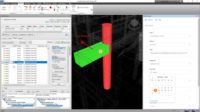Two popular tools for collecting project data, BuildingConnected and PlanGrid, previously operated in their own silos.
Both companies were acquired by by San Rafael, Calif.-based Autodesk in the last year, and their corporate parent has announced a data integration
between them.
Kansas City-based CRB is a design-builder that offers planning, design and construction services and bills itself as "one solution" for clients looking to take on a building project. A new project data connection between two tools it previously used, now owned by San Rafael. Calif.-based Autodesk, could make it easier to share data on their design and construction projects.
A long-time believer in technology, CRB was already using PlanGrid for project management and BuildingConnected for preconstruction data collection. The two companies' new corporate parent, Autodesk, announced that all project data from BuildingConnected can now be shared with PlanGrid - both were acquired in the last year -as part of its effort to streamline connection between its products. BuildingConnected had already allowed CRB to streamline its project data collection. Now, they hope to see similar gains from moving that information to PlanGrid for actual construction.
"If we didn't have BuildingConnected, I would have to create a file, share it with our estimating department, and they would have to go into that file... everything would have to be created by us," says Rob Genge, construction manager at CRB. "So, we were having to use our own Excel sheets. Everything was a file that we saved on a server somewhere, and with BuildingConnected it's all in the cloud. It's all saved for you. It's all accessible by whoever you want to get access to it. And on top of that, it all has the same format. So all of our clients see the same format, whether we use the leveling sheets, they all look the same. All of our subs see the same bid forms."
Autodesk says this integration allows project managers to automatically push design and preconstruction files from BuildingConnected to PlanGrid.
"What we're ultimately doing, is we're going to deliver a comprehensive integrated platform that really seamlessly connects the office, the trailer and the field from design, through the collaboration, design-collaboration process, over to preconstruction out to the site," says Jim Lynch, vice president and general manager of construction solutions at Autodesk.
Lynch acknowledged that such a goal is very lofty with so many different ways of warehousing and protecting project data in the field today, even within Autodesk's own technology portfolio.
"We're not building up to this big crescendo... this big integrated unified platform," Lynch says. "We're stepping toward it in the right way, and that's what these integrations are. These integrations are steps towards an integrated workflow."
The company has been touting similar technology connections between other recent acquisitions such as Assemble Systems and tools that it has managed far longer such as the building information modeling authoring tool, Autodesk Revit.
"This is really part of the overall strategy of the organization, for us to be connected, better connected through our projects from the top down and also throughout our trade partners that we're working with," says Mike Mehrwin, virtual design and construction manager at CRB. "It also it helps us be able to leverage the data analytics part of this."
Autodesk representatives said that BuildingConnected's information can be moved to PlanGrid through a few mouse clicks using the integration process that software engineers from all three entities worked on. Customers of both BuildingConnected and PlanGrid can now use the data transfer capability.
"If I take all my sub-contractors from BuildingConnected and I'm doing the award or the notice to proceed or whatever you want to call it, from there, that I'm able to take that group of subs and that group of information and put it on PlanGrid is very powerful," Genge says. "I'm able to share all that information out to all those people without having to do [each one] as individual parts. That saves me probably two weeks worth of work."





